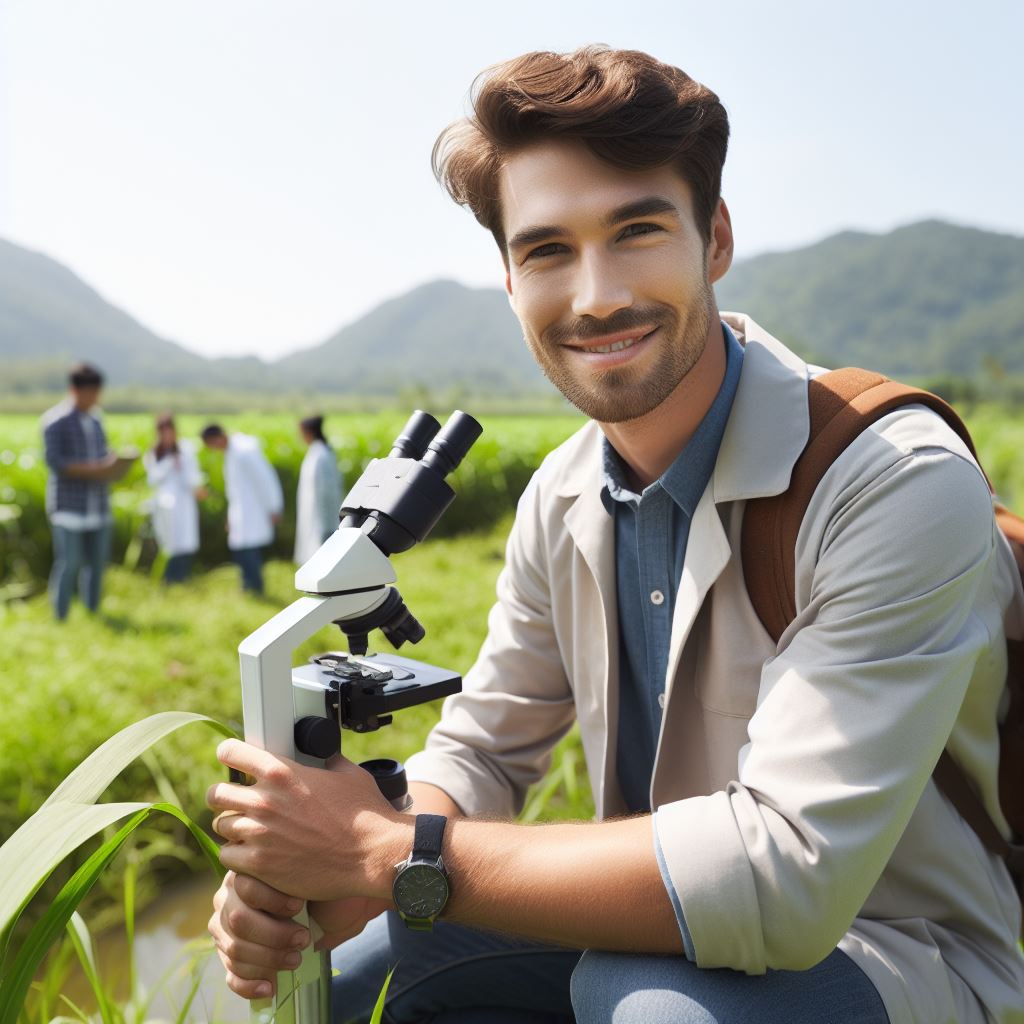Introduction
Definition of modern environmental science
Modern environmental science refers to the study of the natural world and how human activities impact it. In this article we will look at the Role of Technology in Environmental Science
It involves analyzing and understanding various environmental issues, such as pollution, climate change, and biodiversity loss.
With the advancement of technology, the field of environmental science has significantly benefited.
The importance of technological advancement in environmental science
Technology plays a crucial role in modern environmental science in the USA. It has enabled researchers and scientists to collect and analyze vast amounts of data efficiently.
Advanced tools and equipment, such as drones and satellite imagery, allow for accurate monitoring and assessment of environmental conditions.
Additionally, technology has facilitated the development of innovative solutions to environmental problems.
For example, scientists have created sophisticated models and simulations that help predict the impacts of human activities on the environment.
This knowledge aids policymakers and decision-makers in developing effective conservation strategies and regulations.
Moreover, technology has enhanced communication and collaboration among environmental scientists.
Through online platforms and digital tools, researchers from different parts of the country can exchange ideas, share data, and work together on solving complex environmental challenges.
Basically, the role of technology in modern environmental science in the USA cannot be overstated.
It has revolutionized the way environmental research is conducted, provided crucial insights, and facilitated the development of sustainable solutions.
As technology continues to evolve, its impact on environmental science will only grow stronger, offering new possibilities and opportunities for creating a more sustainable future.
Technological advancements in data collection and analysis
Technology has significantly transformed the field of environmental science in the United States.
Advancements in data collection and analysis have revolutionized the way scientists gather information and make informed decisions.
This section will explore key technological tools that have played a pivotal role in modern environmental science.
Remote sensing technology
- Satellite imagery allows for comprehensive and accurate monitoring of the Earth’s surface.
- Aerial drones have revolutionized data collection by providing high-resolution images and videos.
Remote sensing technology allows scientists to collect data from a distance, eliminating the need for direct contact with the environment being studied.
Satellite imagery, one of the key remote sensing technologies, has revolutionized environmental monitoring. Satellites equipped with specialized sensors capture high-resolution images of the Earth’s surface.
These images provide valuable insights into various environmental phenomena, such as deforestation, urbanization, and land-use changes.
By analyzing satellite imagery, scientists can assess the extent and impact of environmental issues.
Aerial drones have also emerged as powerful tools for data collection in environmental science.
Equipped with high-quality cameras, drones can capture detailed images and videos from unique perspectives.
Drones are particularly useful in areas inaccessible to humans, such as rugged terrains or disaster-stricken regions.
They provide valuable information for environmental surveys, biodiversity monitoring, and habitat assessments.
The ability to cover large areas quickly and efficiently makes aerial drones an indispensable tool for environmental researchers.
Geographic Information System (GIS)
- Mapping and spatial analysis using GIS enhance our understanding of environmental patterns.
- Environmental monitoring and management are made more efficient and effective through GIS applications.
Geographic Information System (GIS) is a technology that involves mapping, analyzing, and managing geographic data.
It allows scientists to integrate different types of data, such as satellite imagery, environmental parameters, and human activities, into a digital map for spatial analysis.
GIS plays a crucial role in environmental science by providing valuable insights into patterns and relationships between various elements of the environment.
Mapping and spatial analysis using GIS enable scientists to identify patterns of resource distribution, land-use, and environmental changes.
This knowledge is essential for understanding ecosystems, assessing environmental impacts, and making informed decisions related to land management and conservation.
Additionally, GIS applications support environmental monitoring and management by providing real-time data on environmental parameters such as air quality, water quality, and natural disasters.
Advanced sensors and monitoring devices
- Weather stations equipped with advanced sensors provide real-time meteorological data.
- Water quality monitoring equipment helps in assessing the health of rivers, lakes, and oceans.
- Air pollution sensors play a crucial role in measuring and analyzing air quality parameters.
Advancements in sensor technology have greatly improved the accuracy and efficiency of environmental monitoring.
Weather stations equipped with advanced sensors can provide real-time meteorological data, including temperature, humidity, wind speed, and precipitation.
This information is vital for predicting natural disasters, understanding climate change, and developing effective strategies for mitigating its impacts.
Water quality monitoring equipment helps scientists assess the health and integrity of aquatic ecosystems.
These devices measure various parameters, such as pH levels, dissolved oxygen, turbidity, and nutrient concentrations.
By analyzing these measurements, scientists can detect signs of pollution, track the spread of contaminants, and develop appropriate remediation strategies.
Monitoring water quality is essential for maintaining the health of marine and freshwater ecosystems and ensuring the safety of drinking water sources.
Air pollution sensors are vital for monitoring and managing air quality. They measure different pollutants, such as particulate matter, ozone, carbon monoxide, and nitrogen oxides.
These sensors provide real-time data on air pollution levels, helping scientists understand the sources and impacts of pollution.
By identifying pollution hotspots and analyzing trends, policymakers can implement effective regulations and policies to reduce air pollution and protect public health.
In review, technology plays a crucial role in modern environmental science in the USA.
Technological advancements in data collection and analysis enable scientists to gather accurate and comprehensive information about the environment.
Remote sensing technology, GIS, advanced sensors, and monitoring devices have revolutionized the way we understand, monitor, and manage our natural resources.
These tools are invaluable for making informed decisions and implementing effective strategies to protect and sustain the environment for future generations.
Read: Day in the Life: Routine Tasks for a US-Based Biologist
Technology-based solutions for environmental challenges
Renewable energy technologies
- Solar power: Solar power is a form of renewable energy that utilizes the sun’s rays to generate electricity.
- Wind power: Wind power is another renewable energy source that converts the energy from wind into usable electricity.
- Geothermal energy: Geothermal energy harnesses the heat from within the Earth to produce electricity and heat buildings.
Technology plays a crucial role in addressing environmental challenges faced by modern environmental science in the USA.
Various technological advancements provide solutions that contribute to a sustainable future.
One such solution is the use of renewable energy technologies. Solar power, for example, harnesses the sun’s energy to generate electricity.
The installation of solar panels reduces reliance on fossil fuels, mitigating the environmental impact of energy consumption.
Wind power is another important renewable energy source.
Wind turbines convert the natural movement of air into electricity, reducing greenhouse gas emissions associated with traditional energy generation methods.
The abundance of wind in certain regions of the USA makes it an ideal source of clean energy.
Green infrastructure development
- Sustainable urban planning: Sustainable urban planning involves designing cities that minimize their impact on the environment through energy-efficient buildings and transportation systems.
- Green building technologies: Green building technologies focus on constructing energy-efficient and environmentally conscious buildings.
Geothermal energy taps into the Earth’s heat to produce electricity and heat buildings efficiently.
Utilizing geothermal power significantly reduces dependence on non-renewable energy sources, thus lowering carbon emissions that contribute to climate change.
In addition to renewable energy, technology aids in the development of green infrastructure. Sustainable urban planning incorporates environmental considerations into city design and development.
This includes energy-efficient buildings, walkable neighborhood designs, and accessible public transportation systems that reduce reliance on cars.
Transform Your Career Today
Unlock a personalized career strategy that drives real results. Get tailored advice and a roadmap designed just for you.
Start NowGreen building technologies further enhance environmental sustainability.
These solutions focus on constructing buildings that are energy-efficient, utilize sustainable materials, and minimize waste generation during construction and operation.
Environmental restoration and conservation
- Habitat restoration projects: Habitat restoration projects aim to repair or recreate ecosystems that have been damaged or destroyed.
- Species conservation initiatives: Species conservation initiatives strive to protect and preserve endangered plant and animal species from extinction.
Furthermore, technology enables environmental restoration and conservation efforts. Habitat restoration projects aim to revive ecosystems that have been degraded or destroyed due to human activities.
Through the integration of advanced technologies, such as remote sensing and ecological modeling, scientists can more effectively restore and preserve habitats.
Species conservation initiatives utilize technology to protect and preserve endangered plant and animal species.
Innovative techniques like genetic research, assisted reproductive technologies, and satellite tracking contribute to the conservation and management of vulnerable ecosystems.
In a nutshell, technology-based solutions are at the forefront of addressing environmental challenges in modern environmental science in the USA.
Renewable energy technologies, green infrastructure development, and environmental restoration and conservation initiatives all rely on technological advancements to create a more sustainable future.
Read: Top Universities for Aspiring Biologists in the USA
Gain More Insights: Continuous Learning: Post-graduate Options for US Biologists
Collaboration and communication advancements through technology
Technology has played a significant role in transforming environmental science in the USA, particularly in collaboration and communication among scientists and the general public.
Advances in technology have provided numerous tools and platforms for scientists to work together, share findings, and engage the public in environmental issues.
Virtual collaboration tools
- Web-based platforms for scientific research
- Virtual conference and workshops
Virtual collaboration tools have revolutionized the way scientists collaborate on research projects.
Web-based platforms have emerged, allowing scientists from different institutions to share data, findings, and collaborate effectively.
These platforms facilitate real-time collaboration, eliminating geographical barriers and enabling efficient and seamless teamwork.
Similarly, virtual conferences and workshops have gained popularity due to their convenience and cost-effectiveness.
Scientists can participate in conferences and workshops from anywhere in the world, reducing the need for travel and ensuring a larger pool of participants.
These virtual gatherings foster collaboration, knowledge exchange, and the dissemination of research findings.
Social media and online communities
- Sharing knowledge and best practices
- Raising awareness and mobilizing public support
Social media and online communities have become essential tools for scientists to connect, share knowledge, and build networks.
These platforms enable scientists to share their research, findings, and best practices with a wider audience.
The widespread availability of scientific information through social media allows for rapid knowledge dissemination and facilitates faster progress in the field of environmental science.
Moreover, social media platforms play a crucial role in raising awareness and mobilizing public support for environmental causes.
Scientists can engage directly with the public, sharing information about environmental issues, their research, and the importance of conservation.
Social media campaigns can mobilize public action, pushing for policy changes and promoting sustainable practices.
Open data and Citizen Science initiatives
- Crowdsourcing environmental data collection
- Engaging public participation in scientific research
The emergence of open data and citizen science initiatives has further enhanced collaboration and communication in environmental science.
Open data initiatives encourage scientists to share their data openly, making it accessible to the wider scientific community. This promotes reproducibility, transparency, and collaborative research.
Citizen science initiatives involve the general public in scientific research by allowing them to contribute to data collection and analysis.
Crowdsourcing environmental data collection through smartphone applications, for example, enables a diverse range of individuals to report findings and contribute to scientific research.
Engagement of the public not only expands the scope of environmental data but also promotes a sense of ownership and involvement in scientific endeavors.
All in all, technology has played an instrumental role in advancing collaboration and communication in modern environmental science in the USA.
Virtual collaboration tools, social media platforms, and open data initiatives have revolutionized the way scientists work together, share knowledge, and engage the public in scientific research.
These advancements have not only improved the efficiency of scientific collaboration but also fostered public awareness and participation in environmental issues.
Read: Job Outlook: Future Demand for Biologists in America

Challenges and ethical considerations in utilizing technology in environmental science
Privacy and security concerns
- The integration of technology in environmental science raises concerns about the privacy of individuals.
- Collection and analysis of personal data through technology might infringe upon individuals’ rights.
- Environmental monitoring devices can gather sensitive information, leading to potential privacy breaches.
- Safeguarding data from unauthorized access and ensuring secure storage are critical ethical considerations.
- Stricter regulations and policies should be implemented to protect individuals’ privacy in environmental science research.
Data accuracy and reliability
- Technology plays a crucial role in collecting vast amounts of data in environmental science.
- Ensuring the accuracy and reliability of these data sets is a significant ethical challenge.
- Environmental scientists must carefully validate and verify data to ensure its integrity.
- Utilizing advanced algorithms and quality control measures can help minimize errors and improve data reliability.
- Collaboration between scientists, statisticians, and technology experts is essential for the verification process.
Equity and accessibility issues
- The use of technology in environmental science can exacerbate existing disparities in access to information and resources.
- Communities with limited access to technology may be left out of important environmental research and decision-making processes.
- Efforts should be made to bridge the digital divide and ensure equal opportunities for all.
- Providing training and resources to underprivileged areas can help mitigate equity and accessibility barriers.
- Environmental scientists need to consider the equitable distribution of technology and address potential biases in data collection.
Proper use and disposal of electronic waste
- Advancements in technology lead to the rapid obsolescence of electronic devices, creating significant electronic waste.
- Ethical considerations arise in the responsible use and disposal of these devices in environmental science.
- Recycling and proper disposal of electronic waste are essential to minimize their environmental impact.
- Environmental scientists should prioritize the use of sustainable and recyclable technologies.
- Collaborating with organizations specializing in e-waste management ensures responsible disposal and reduces environmental harm.
Most importantly, integrating technology into modern environmental science brings along significant challenges and ethical considerations.
Privacy and security concerns must be addressed to protect individuals’ rights and data. Ensuring the accuracy and reliability of data requires collaboration and quality control measures.
Equity and accessibility issues need to be mitigated to include all communities in environmental research. Proper use and disposal of electronic waste is crucial to minimize environmental impact.
By addressing these challenges, the role of technology in environmental science can be maximized while upholding ethical standards.
Read: Salary Expectations: Biologists‘ Earnings Across the States
You Might Also Like: Future of Nuclear Science and Technology
Delve into the Subject: How to Become a Virologist: Education and Training
Conclusion
A recap of the importance of technology in modern environmental science
Technology plays a crucial role in modern environmental science in the USA.
It enables scientists to collect and analyze vast amounts of data, monitor environmental changes, and develop sustainable solutions to complex issues.
Without technology, our understanding of the environment would be limited, and our ability to protect and conserve it would be compromised.
Transform Your Career Today
Unlock a personalized career strategy that drives real results. Get tailored advice and a roadmap designed just for you.
Start NowFuture possibilities and potential advancements
As technology continues to advance, the possibilities for its integration into environmental science are endless.
The development of more sophisticated sensors, drones, and remote sensing technologies will allow scientists to gather even more accurate and detailed data.
Artificial intelligence and machine learning algorithms can help analyze complex environmental patterns and predict future changes.
These advancements have the potential to revolutionize how we study and manage our environment.
Final thoughts on the integration of technology and environmental science
The integration of technology and environmental science is essential for addressing the environmental challenges we face today.
It empowers us to make informed decisions, develop sustainable practices, and protect our ecosystems.
However, we must also be mindful of the potential drawbacks of technology, such as data privacy concerns and technological dependence.
Therefore, a balanced approach that combines technological advancements with ethical considerations is crucial.
In the end, technology has become an indispensable tool in modern environmental science in the USA. It has revolutionized how we study, understand, and protect our environment.
By leveraging technology and exploring future possibilities, we can continue to make significant advancements in environmental science and pave the way for a more sustainable future.




